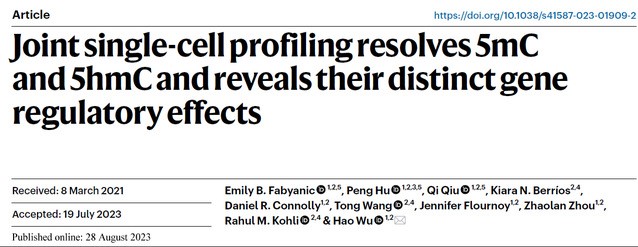Recently, Professor Hu Peng from SHOU and HaoWu’s team from the Department of Genetics at the University of Pennsylvania jointly published an article titled Joint Single-cell Profiling Resolves 5mCand 5hmC and Reveals Their Distinct Gene Regulatory Effects (doi:10.1038/s41587-023-01909-2). Professor Hu Peng is a co-first author of this article. The corresponding author, Associate Professor Hao Wu from the University of Pennsylvania, is the postdoctoral supervisor of Professor HuPeng. SHOU is the cooperative unit. Nature Biotechnology is a major part of the prestigious Nature journal series, focusing on publishing breakthrough research on cutting-edge biotechnology.

DNA cytosine methylation (5mC) is an important epigenetic modification involved in regulating cell-specific gene expression,maintaining genomic stability and other key processes. TET family proteins can oxidize 5mC into cytosine hydroxymethylation (5hmC), thereby achieving demethylation and dynamically adjusting the cytosine modification of the genome. However, it is difficult to accurately distinguish between 5mC and 5hmC modifications using traditional bisulfite sequencing, which limits the ability to quantitatively detect these two DNA modifications at the single-cell level.
To overcome this challenge, researchers have developed a single-cell sequencing technique called Joint-snhmC-seq (Jointsingle-nucleus (hydroxy)methylcytosine sequencing), which can simultaneously detect DNA 5hmC and 5mC modifications. Using this technique, research teamshave analyzed the 5mC and 5hmC modification sites of different cell types inthe cerebral cortex, and delved into the unique regulatory mechanisms of these two modifications at different gene loci. It is found that long genes often maintain high levels of 5mC modification, without compromising their transcription levels.
This technique provides a platform for studying 5hmC modification and true 5mC modification at the single-cell level, and is expected to deepen our understanding of the biological functions of these modifications in complex tissues. This collaborative achievement is not only of great significance in the field of biotechnology, but also offers acutting-edge technological means for probing into methylation and demethylation modifications in aquatic animals.